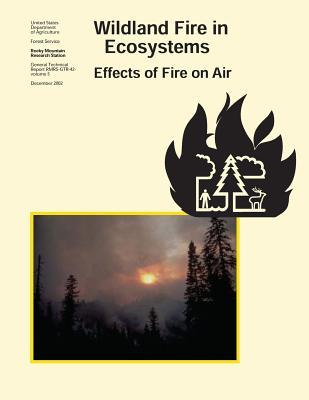Read Online Wildland Fire on Ecosystems: Effects of Fire on Air - U.S. Department of Agriculture file in ePub
Related searches:
392 2747 2341 1378 196 4540 786 1963 780 1485 4745 2927 986 3791 2059 3853 3776 484 1555 633 3544 3136 1932 30 2703 4389 631 3210 4573
Trees to restore and maintain ecosystems and limit the negative impacts of wildfires. During a wildland fire all kinds of plant material can act as fuel, including.
Wildland fire in ecosystems: effects of fire on cultural resources and archeology. Wildland fire in ecosystems: effects of fire on soil and water�.
Ecosystem, fire effects, fire management, fire regime, fire severity, fuels, habitat, plant response, plants, succession, vegetation related search. Fire ecology and management in lowland riparian ecosystems of the southwestern united states and northern mexico; chapter 12: gaps in scientific knowledge about fire and nonnative invasive plants.
Plants on the forest floor or smaller trees are often destroyed by wildfires, while larger trees are able to survive as long as the fire does not spread into the tree.
This state-of-knowledge review about the effects of fire on soils and water can assist land and fire managers with information on the physical, chemical, and biological effects of fire needed to successfully conduct ecosystem management, and effectively inform others about the role and impacts of wildland fire.
Fire breaks open the outside coating of mountain lilac seeds and stimulates germination in southern california chaparral. Aspen, birch, and willow sprout from their roots after a fire.
Feb 28, 2012 consequently, there is now a forest “fire deficit” in the western united states attributable to the combined effects of human activities, ecological,.
Buy wildland fire in ecosystems: effects of fire on soil and water on amazon. Com free shipping on qualified orders wildland fire in ecosystems: effects of fire on soil and water: united states department of agriculture: 9781508890027: amazon.
In 1978, a national workshop on fire effects in denver, colorado provided the impetus for the “effects of wildland fire on ecosystems” series. Recognizing that knowledge of fire was needed for land management planning, state-of-the-knowledge reviews were produced that became known as the “rainbow series.
One of the most important ecological effects of burning is the increased probability of further burning in subsequent years, as dead trees topple to the ground,.
What is fire ecology? fire ecology is a branch of ecology that focuses on the origins of wildland fire and it's relationship to the environment that surrounds it, both.
Fire can act as a catalyst for promoting biological diversity and healthy ecosystems, reducing buildup of organic debris, releasing nutrients into the soil, and triggering changes in vegetation community composition. Fire severity refers to the ecosystem impacts of a fire, and an individual fire may have a range of fire severity.
Wildland fire in ecosystems: effects of fire on cultural resources and archeology. Wildland fire in ecosystems: effects of fire on soil and water.
Department of agriculture, forest service, rocky mountain research station. Fires affect animals mainly through effects on their habitat.
Jan 15, 2020 perhaps surprisingly, the animal casualties from wildfires are low—animals survive by burrowing into the ground or fleeing to safer areas.
Cultural resources are at risk of being damaged by wildfires as well as active natural resource management.
This state-of-knowledge review about the effects of fire on air quality can assist land, fire, and air resource managers with fire and smoke planning, and their efforts to explain to others the science behind fire-related program policies and practices to improve air quality.
Ogden, ut: usda forest service, rocky mountain research station.
Many ecosystems benefit from periodic fires, because they clear out dead organic material—and some plant and animal populations require the benefits fire brings to survive and reproduce. For example, as dead or decaying plants begin to build up on the ground, they may prevent organisms within the soil from accessing nutrients or block animals on the land from accessing the soil.
Social and economic impacts of wildfire emissions? new scientific tools are needed to better quantify and predict the impact of smoke from wildland fires on public.
Chapter topics include fire regime classification, autecological effects of fire, fire regime characteristics and postfire plant community developments in ecosystems throughout the united states and canada, global climate change, ecological principles of fire regimes, and practical considerations for managing fire in an ecosytem context.
Current: wildland fire in ecosystems: effects of fire on cultural resources and archaeology; wildland fire in ecosystems: effects of fire on cultural resources and archaeology this article contains other documents.
Despite the myriad benefits of fires in forests, high severity fires that burn trees completely and bake soils can take decades to regenerate significant vegetation,.
Like fire effects on populations, fire effects on communities are related to the amount of structural change in vegetation. Bird abundance and diversity are likely to be greatest early in succession. When shrub or tree canopy closure occurs, species that prefer open sites and habitat edges decline and species that prefer mature structures increase.
Wildland fire is a natural component of appalachian ecosystems—rare in some fire regimes can sometimes have negative effects on ecosystem services.
Fires often cause short-term increases in wildlife foods that contribute to increases in populations of some animals. These increases are moderated by the animals' ability to thrive in the altered, often simplified, structure of the postfire environment. The extent of fire effects on animal communities generally depends on the extent of change in habitat structure and species composition caused by fire.

Post Your Comments: